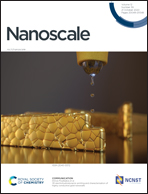Fe(ii)-Assisted one-pot synthesis of ultra-small core–shell Au–Pt nanoparticles as superior catalysts towards the HER and ORR†
Abstract
In this work, uniform ultra-small core–shell Au–Pt nanoparticles (denoted as USCS Au–Pt NPs) with Au-decorated Pt surfaces are successfully prepared by Fe(II)-assisted one-pot co-reduction of Au(III) ions and Pt(II) ions in a citrate solution. The as-prepared USCS Au38.4@Au9.3Pt52.3 NPs have an average diameter of 2.3 ± 0.5 nm. It is found that the morphology, composition and size of Au–Pt NPs are highly dependent on the reaction conditions including the addition sequence of the precursors, and the concentrations of Fe(II) ions, Au(III) ions and Pt(II) ions. In addition, USCS Au38.4@Au9.3Pt52.3-NP/C catalysts (USCS Au38.4@Au9.3Pt52.3 NPs loaded on the Vulcan XC-72R carbon black) exhibit excellent electrocatalytic performance towards the hydrogen evolution reaction (HER) and the oxygen reduction reaction (ORR) in acidic media due to the higher electrochemically active surface area (ECSA) and electronic effect between Pt and Au. For instance, USCS Au38.4@Au9.3Pt52.3-NP/C catalysts exhibited greatly enhanced HER activity in terms of overpotential (16 mV at a current density of −10 mA cm−2) and are better than commercial Pt/C catalysts (31 mV at a current density of −10 mA cm−2) reported in the literature thus far, to the best of our knowledge. Strikingly, their mass activity is about 13.1-fold higher than that of commercial Pt/C catalysts. Moreover, they also show an improved ORR activity, Eonset = 1.015 V and E1/2 = 0.896 V, which are positively shifted by nearly 28 mV and 21 mV than those of commercial Pt/C catalysts (0.987 V and 0.875 V), respectively. In addition, they also showed a higher kinetic current density (12.85 mA cm−2 at 0.85 V) and a better long-term durability. Our synthetic strategy presented here may be extended to the preparation of ultra-small Au-based bimetallic or multi-metallic NPs.



 Please wait while we load your content...
Please wait while we load your content...